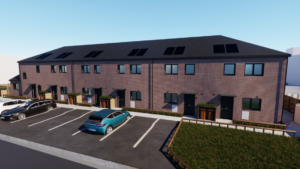Should housing associations build homes or neighbourhoods?
 Housing associations have expanded their brief within communities and now play key roles in tackling poverty and worklessness. Can – and should – they become neighbourhood leaders, asks Austin Macauley
Housing associations have expanded their brief within communities and now play key roles in tackling poverty and worklessness. Can – and should – they become neighbourhood leaders, asks Austin Macauley
The ongoing task of the National Housing Federation to bring a unified voice to the UK’s housing associations is, in its own members’ words, like herding cats. Its latest attempt, An ambition to deliver, sets out a vision for the sector over the next 20 years ‘about what housing associations large and small can do to build homes and communities’. It may well be representing an increasingly disparate group of organisations, but the NHF understands that now more than ever its members’ time has come.
With local government in retreat, the voluntary and community sectors battered and bruised, major regeneration funding long gone and housing need spiralling out of control, social landlords are now often the last man standing (New Start, November 2011). They have the assets – worth in excess of £100bn – the in-built social purpose, the community presence and the ability to influence the lives of some of the most vulnerable in society. With the impact of welfare reform hitting tenants and causing rising rent arrears, the need to find new ways to improve their customers’ lives grows by the day.
While some landlords are retreating back to their core original task of building, managing and maintaining housing, many have branched out into wider neighbourhood work, whether it’s tackling worklessness, promoting enterprise or supporting health initiatives. But the spectrum of activity is huge. Some housing associations are putting themselves out there as major players in guiding neighbourhood transformation. It begs the question – could, and should, they do more?
Broadening the sector’s collective offer
Generalisations about the social housing sector have always been difficult, even before the rapid rate of change seen in the last five years. Landlords’ size, structure, resources and local context vary enormously. But increasingly there’s a sense that housing associations are choosing one of two paths.
‘There’s been a big period of introspection for the sector and different housing associations have made different choices about what type of organisation they want to be – which way they want to face,’ says NHF policy officer Sara Cunningham. Some are choosing to focus on development while others are ‘more locally based, philanthropic, socially focused organisations’, but all are housing associations at heart, she says.
Will Nixon, director of regeneration at Staffordshire-based housing association Aspire, believes the trend is well established. ‘For a while the sector has probably been split in two: those focused on growth and units and financial capacity and those that have a placeshaping agenda. I don’t detect a discernable change.’
The former have tended to be the largest organisations, many of which have been able to raise substantial amounts of investment from capital markets. But their expansion – whether in terms of acquisitions or the scale of their development portfolios – has led to a perception that it’s made them more remote from the communities they serve. An ambition to deliver predicts the sector will become more diverse, ‘meaning our collective offer will be broader and more ambitious in 20 years, but will be held together by a strong shared sense of social purpose’. In terms of delivering on their social purpose on the ground, are some ways more effective than others?

Limehurst Village estate near Oldham, where housing association Regenda has taken on the role of ‘neighbourhood leader’
The placeshapers
A growing number of housing associations see placemaking as both their role and responsibility – working with local authorities, businesses, the third sector and others to bring about sustainable improvement and create opportunities for the locality as a whole. The journey taken by Aspire mirrors many of them. Created by stock transfer in 2000, it had reached a point where it had delivered on its original promises to refurbish housing and, says Nixon, was asking itself ‘where next?’. The landlord commissioned research to examine the main issues people in its neighbourhoods were dealing with. It unearthed a host of socio-economic concerns, such as poor health, low skills and unemployment.
Aspire’s response was to buy a local training company, PM Training, in 2008. ‘Part of the thinking was the younger we work with individuals the more chance we have to see positive community change over a period of time,’ explains Nixon. ‘It’s not a short-term fix, it’s about long-term regeneration.’
Over the last two years PM Training has been responsible for the most young apprenticeship starts in Staffordshire and is now an integral part of Enterprising Futures, the social enterprise arm of Aspire.
‘I suppose we have been unswerving from our purpose as an entity. Even with the raft of policy change, welfare reform etc we are very clear that the single biggest mitigating factor to welfare reform is to get people into jobs,’ says Nixon. ‘It not only makes absolute strategic sense as an organisation it makes business sense. I understand that some organisations cower and retract a bit, but that’s not us.’
On the Limehurst Village estate near Oldham, housing association Regenda has taken on an even more explicit placemaking role. It has established a neighbourhood co-operative agreement with Oldham Council committing both parties to a ten-year strategy to improve the estate. It encompasses physical regeneration – including £5m investment from Regenda – as well as support for enterprise and a sports and wellbeing programme. The landlord has been working with the Centre for Local Economic Strategies to ensure the work has both sustainability and resilience at its core. Genuine resident involvement and maximising the links between Limehurst and the wider economy will be key.
‘We hope what we’re doing in Limehurst is transferable and will see how you can adapt it in other settings,’ says Bill Lovat, regional director at Regenda. ‘It’s about recognising that, in lots of areas, partners, stakeholders and funders have gone. If we want long-term resilience, successful housing and communities we have got to take a much more proactive role and think ahead. Don’t become too obsessed with the impact of welfare reform. Look at your role as a neighbourhood leader.’
‘Mini engines for the economic recovery’
In Birmingham and Black Country one landlord is helping to lead an initiative designed to drive forward the civic economy. Jas Bains, who leads on socio-economic regeneration for Accord Group, describes Futureshift as being ‘about building confidence and capacity in communities’ as the state’s role diminishes. He believes housing associations have to be more open to a far broader role, be willing to let go and play the role of enabler and facilitator. ‘I think this is increasingly where our focus is being channelled – mini engines for the economic recovery.’
Standing at the forefront of this ‘social landlord as neighbourhood champion’ role is Poplar Harca in London. It’s engrained in its raison d’être (Harca stands for housing and regeneration community association) and it has been working to turn around what are some of the capital’s poorest areas for more than 15 years. ‘The bigger housing associations are in some cases building the solutions to a different set of problems,’ says Babu Bhattacherjee, director of communities and neighbourhoods. There are more fundamental issues to be addressing than the supply of new homes, for example. ‘These are important problems but there’s also the deep-seated issues around poverty, employment, educational attainment.’
One thing Aspire, Accord, Regenda and Polar Harca have in common is they are members of Placeshapers, a network of more than 100 housing associations committed to a set of shared principles. Among them is the need to support local government – day to day and strategically – in improving and shaping places. Tony Stacey, who chairs Placeshapers, says new members often have a sense of ‘great relief’ on joining and finding themselves among like-minded organisations. Part of their task has been to provide a counter voice to the many vocal proponents of consolidation within the sector.
Mergers can make tenants feel more remote, says Stacey, citing evidence from two Chartered Institute of Housing reports. But he believes they’ve got their message across. ‘It’s now generally recognised that being a medium-sized community focused association is a legitimate strategy.’ Housing associations created from stock transfer, with a concentration of homes in one area will, he predicts, ‘become major regeneration agencies, partly because there isn’t anybody else and they have the resources to have the impact’.
Can government join the dots?
It could be argued that housing associations on the ‘other’ path – the volume house builders focused on major investment – are simply answering the coalition government’s call. Its primary – some would say only – engagement with the sector has been around the need to build more homes. But with much-reduced subsidy on offer and government pushing for homes to be built for sale and affordable rather than social rent, it’s hard to see how this will benefit the poorest in society.
Government isn’t making it easy for social landlords to play a wider regeneration role. Cuts to housing benefit – and in particular the bedroom tax – are chipping away housing associations’ bottom line while exacerbating the social and economic issues faced by tenants. Two-thirds of England’s 3.7 million social renters receive housing benefit to help pay their rent. Should landlords use affordable rents to target a slightly more affluent and less cumbersome cohort of tenants?
Babu Bhattacherjee believes that without regeneration funding or adequate subsidy landlords committed to placemaking will opt for ‘building fewer homes and building better neighbourhoods’.
The Homes and Communities Agency has considered tighter regulation as a way to deal with the increasing commercial activity of the social housing sector – something opponents have warned could stop landlords taking a broader placemaking role. But the biggest issue is what government and its agencies are not saying.
‘What they [the sector] don’t have is any sort of leadership on regeneration from government,’ says Sara Cunningham. ‘Since the demise of housing market renewal there’s been an absence of vision and leadership for areas that are not thriving. Perhaps there’s an expectation that housing associations will just fill the gaps, but without any leadership or enabling structures it’s difficult to see how they can do that.’
Government’s influence over parts of the sector is undoubtedly waning as landlords increasingly rely on private investors to fund their activities. Jas Bains believes too many housing associations ‘wait for government to guide them and tell them what the latest strategy is’. If there’s any message from government at the moment it is that ‘it’s down to you’, he says. But what if government was to connect the £21bn a year it spends on social housing via benefits with transformation on the ground?
‘Where government still has huge influence is the size of the housing benefit bill. If it was willing to enter into a 15-20 year social contract with housing associations it could say that for the £21bn you will deliver X, Y and Z in social value. It could be a win-win.’
- Read the rest in our series on housing associations here.
















